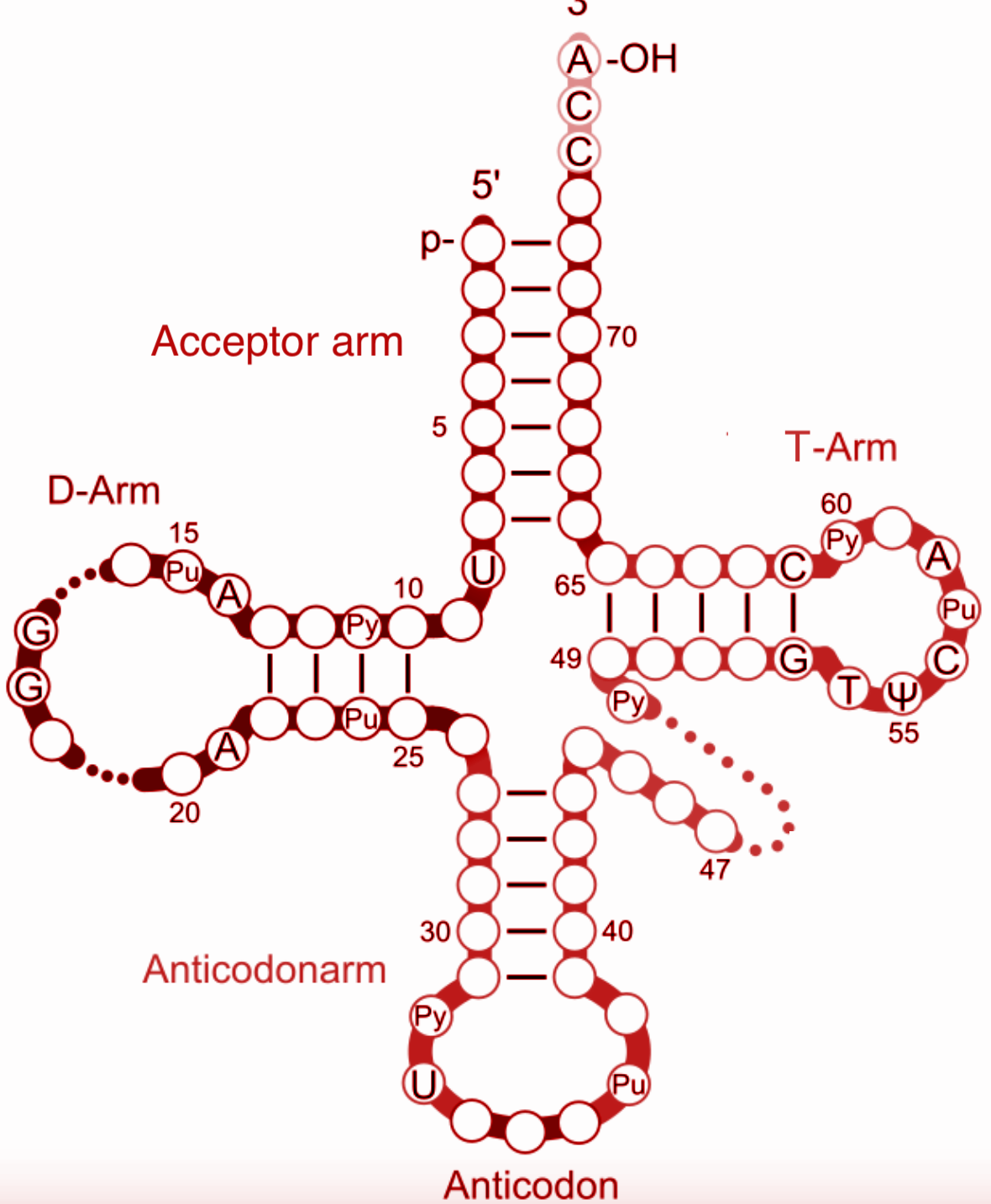
Draw and label the structure of tRNA.
Answer
490.8k+ views
Hint: Transfer RNA, also called amino acid acceptor RNA, adaptor RNA, or soluble RNA, is the RNA that transfers activated amino acids from the amino acid pool of cytoplasm to the protein synthetic site on ribosomes. Thus, it serves as an intermediate molecule, adaptor molecule, or connector molecule between a particular amino acid and a specific codon of mRNA. They are the smallest of all nucleic acid molecules. A tRNA molecule is formed of 70- 100 nucleotide residues. A striking feature, common to all tRNAs, is the folding of the primary chain.
Complete answer:
The cloverleaf configuration of tRNA has five structural regions or double-helical arms, namely the acceptor arm, anticodon arm, thymine-pseudouracil arm, dihydro-uridine arm, and extra arm. The acceptor's arm is concerned with recognizing and binding specific amino acids. So, it is often called the amino acid binding site. It is formed by the base- pairing between the nucleotides of the 5’&3’ ends.

The Anticodon arm has two parts namely, the anticodon stem and the terminal anticodon loop. The loop is usually formed of seven nucleotides, with the terminal nucleotide triplet. The thymine- pseudouracil arm has a basal stem and terminal thymine-pseudouracil loop. This loop is formed of nearly 7 nucleotides with the obligatory presence of pseudouridine. Dihydrouridine arm also has a basal stem and a terminal DHU loop. The loop is usually composed of 8 to 12 nucleotides. The Extra arm may not be present in all tRNAs. It gets the so- called little loop or mini loop, whose shape and nucleotide number vary in different species of tRNAs.
Additional information:
- tRNAs amount to nearly
- tRNA are all single- stranded with 70 - 100 nucleotide residues.
- All tRNAs are identical in that their 3’ end has a CCA-Oh terminus and 5’ end has a G or C terminus.
- tRNAs contain high proportions of some unusual bases, many of which are the methylated forms of the standard ones.
- Nearly half of the nucleotides of tRNAs are base- paired to form double- helical stems, which her terminal loops of unpaired bases.
- Charged tRNAs serve as the source of amino acids for the synthesis of peptide chains.
Note:
- The cloverleaf model of tRNA has certain fundamental features; There is the presence of some unusual bases in regions where hydrogen bonding does not occur.
- The 3’ end and 5’ end of the molecule are close to each other due to folding. The overall distance between the CCA terminus and the anticodon terminus is, same and constant in all species of tRNA.
- The possible difference in the distance due to the difference in the number of nucleotides would be corrected by adjusting the size of the extra loop.
Complete answer:
The cloverleaf configuration of tRNA has five structural regions or double-helical arms, namely the acceptor arm, anticodon arm, thymine-pseudouracil arm, dihydro-uridine arm, and extra arm. The acceptor's arm is concerned with recognizing and binding specific amino acids. So, it is often called the amino acid binding site. It is formed by the base- pairing between the nucleotides of the 5’&3’ ends.

The Anticodon arm has two parts namely, the anticodon stem and the terminal anticodon loop. The loop is usually formed of seven nucleotides, with the terminal nucleotide triplet. The thymine- pseudouracil arm has a basal stem and terminal thymine-pseudouracil loop. This loop is formed of nearly 7 nucleotides with the obligatory presence of pseudouridine. Dihydrouridine arm also has a basal stem and a terminal DHU loop. The loop is usually composed of 8 to 12 nucleotides. The Extra arm may not be present in all tRNAs. It gets the so- called little loop or mini loop, whose shape and nucleotide number vary in different species of tRNAs.
Additional information:
- tRNAs amount to nearly
- tRNA are all single- stranded with 70 - 100 nucleotide residues.
- All tRNAs are identical in that their 3’ end has a CCA-Oh terminus and 5’ end has a G or C terminus.
- tRNAs contain high proportions of some unusual bases, many of which are the methylated forms of the standard ones.
- Nearly half of the nucleotides of tRNAs are base- paired to form double- helical stems, which her terminal loops of unpaired bases.
- Charged tRNAs serve as the source of amino acids for the synthesis of peptide chains.
Note:
- The cloverleaf model of tRNA has certain fundamental features; There is the presence of some unusual bases in regions where hydrogen bonding does not occur.
- The 3’ end and 5’ end of the molecule are close to each other due to folding. The overall distance between the CCA terminus and the anticodon terminus is, same and constant in all species of tRNA.
- The possible difference in the distance due to the difference in the number of nucleotides would be corrected by adjusting the size of the extra loop.
Latest Vedantu courses for you
Grade 11 Science PCM | CBSE | SCHOOL | English
CBSE (2025-26)
School Full course for CBSE students
₹41,848 per year
Recently Updated Pages
Master Class 9 General Knowledge: Engaging Questions & Answers for Success

Master Class 9 English: Engaging Questions & Answers for Success

Master Class 9 Science: Engaging Questions & Answers for Success

Master Class 9 Social Science: Engaging Questions & Answers for Success

Master Class 9 Maths: Engaging Questions & Answers for Success

Class 9 Question and Answer - Your Ultimate Solutions Guide

Trending doubts
Give 10 examples of unisexual and bisexual flowers

Draw a labelled sketch of the human eye class 12 physics CBSE

Differentiate between homogeneous and heterogeneous class 12 chemistry CBSE

Differentiate between insitu conservation and exsitu class 12 biology CBSE

What are the major means of transport Explain each class 12 social science CBSE

What is the difference between resemblance and sem class 12 social science CBSE




